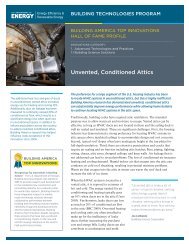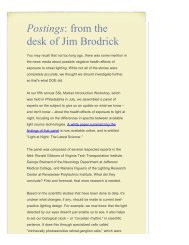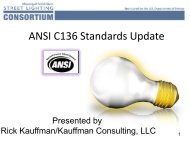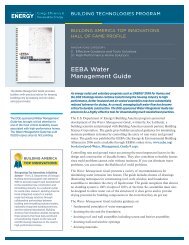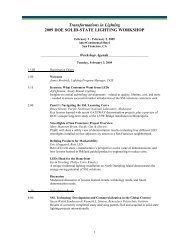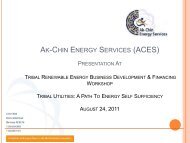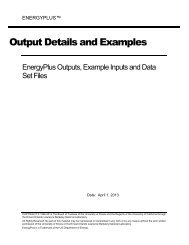EnergyPlus Interface Developer's Guide - EERE - U.S. Department ...
EnergyPlus Interface Developer's Guide - EERE - U.S. Department ...
EnergyPlus Interface Developer's Guide - EERE - U.S. Department ...
Create successful ePaper yourself
Turn your PDF publications into a flip-book with our unique Google optimized e-Paper software.
ENERGYPLUS<br />
<strong>Guide</strong> for <strong>Interface</strong> Developers<br />
EverythingYou Need to Know about <strong>EnergyPlus</strong><br />
Input and Output<br />
(todevelopauser-friendlyinterface)<br />
COPYRIGHT © 1998-2013 The Board of Trustees of the University of Illinois and the Regents of the University of California through<br />
the Ernest Orlando Lawrence Berkeley National Laboratory.<br />
All Rights Reserved. No part of this material may be reproduced or transmitted in any form or by any means without the prior written<br />
permission of the University of Illinois or the Ernest Orlando Lawrence Berkeley National Laboratory.<br />
<strong>EnergyPlus</strong> is a Trademark of the US <strong>Department</strong> of Energy.<br />
Date: April 1, 2013
TABLE OF CONTENTS<br />
Introduction ......................................................................................................................................1<br />
Figure 1. <strong>EnergyPlus</strong> Input/Output Overview ........................................................1<br />
<strong>Interface</strong> Expectations.....................................................................................................2<br />
Input <strong>Interface</strong> Attributes ...........................................................................................2<br />
Post-processing <strong>Interface</strong> Attributes ..........................................................................2<br />
<strong>EnergyPlus</strong> Install Contents ............................................................................................................3<br />
Input Overview.................................................................................................................................5<br />
General Input Rules ........................................................................................................5<br />
Input Data Dictionary.......................................................................................................6<br />
Rules specific to the Input Data Dictionary ................................................................6<br />
Input Data File.................................................................................................................6<br />
Rules specific to Input Data file:.................................................................................6<br />
Input Details .....................................................................................................................................7<br />
IDD Conventions .............................................................................................................7<br />
IDD – IP Units..........................................................................................................10<br />
Example Object.......................................................................................................13<br />
Using the Input-Output Reference Document ..........................................................14<br />
Figure 2. Using IDFEditor to find the latest groups and objects for the<br />
Energy+.idd ........................................................................................................15<br />
Standard <strong>EnergyPlus</strong> Units ...........................................................................................16<br />
Table 1. Standard <strong>EnergyPlus</strong> Units ...................................................................16<br />
<strong>EnergyPlus</strong> Reports ......................................................................................................17<br />
Output ............................................................................................................................................18<br />
Figure 3. Example Chart from Standard Output File...........................................19<br />
Weather Data.................................................................................................................................20<br />
Running <strong>EnergyPlus</strong>......................................................................................................................21<br />
Table 2. <strong>EnergyPlus</strong> Output Files.......................................................................21<br />
4/1/13 i
TABLE OF CONTENTS<br />
Table 3. <strong>EnergyPlus</strong> Errors................................................................................22<br />
Table 4. Timings Comparison (<strong>EnergyPlus</strong> vs. BLAST) .....................................22<br />
Licensing........................................................................................................................................23<br />
Appendix A. Simple IDF file..........................................................................................................24<br />
4/1/13 ii
Introduction <strong>Interface</strong> Expectations<br />
Introduction<br />
This document is intended for developers who are creating user interfaces for <strong>EnergyPlus</strong>. It<br />
provides an overview of the essentials of the input-output structure of <strong>EnergyPlus</strong> and<br />
describes the parts of each in detail.<br />
File Types<br />
Data Dictionary File (IDD)<br />
File produced by Energy Plus developers.<br />
Input Data File (IDF)<br />
File created by interfaces.<br />
Weather Data File (EPW)<br />
File created by weather processor.<br />
Overview of IDF Format<br />
Section;<br />
Object,data,data,…,data;<br />
Object,data,data,…,data;<br />
End Section;<br />
Input <strong>EnergyPlus</strong> Program<br />
Main Program<br />
Module<br />
Module<br />
Module<br />
Module<br />
Module<br />
Module<br />
Figure 1. <strong>EnergyPlus</strong> Input/Output Overview<br />
Output<br />
File Types:<br />
Standard Reports<br />
Standard Reports (Detail)<br />
Optional Reports<br />
Optional Reports (Detail)<br />
Initialization Reports<br />
Overview of File Format:<br />
Header<br />
Data Dictionary<br />
Data<br />
Note: These files will<br />
created by <strong>EnergyPlus</strong>.<br />
The diagram shown above should give the reader an overall picture of input-output in<br />
<strong>EnergyPlus</strong>. It can be seen as a linear process that includes the following steps:<br />
1) The user enters building description (including internal space gains, HVAC<br />
arrangements, and Plant equipment properties) using the interface of their choice. In<br />
addition, the user specifies which non-default reports are desired and any optional<br />
variables from a predefined list of available simulation quantities.<br />
2) The interface program writes the Input Data File (IDF) file, which includes the<br />
specification of any report items desired by the user.<br />
3) <strong>EnergyPlus</strong> processes both the Input Data Dictionary (IDD) and the Input Data File (IDF)<br />
files with the “InputProcessor”. The InputProcessor uses the specifications/rules defined<br />
in the IDD and interprets the IDF raw data. The InputProcessor is really quite “dumb” and<br />
only understands a few things about each field (alpha or numeric) qualified by certain key<br />
elements in the IDD (\ comments which are discussed later).<br />
4) Each module in <strong>EnergyPlus</strong> has one or several routines (normally called “GetInput”<br />
routines) that obtain the information from the IDF file data. These subroutines decode<br />
the portion of the IDF file that is pertinent to the local module. These GetInput routines<br />
are more context sensitive than the InputProcessor and may perform further error<br />
detection. For example, the cooling coil module may read in the coil type and its<br />
associated parameters (number of rows, tube diameter, fin spacing, etc.).<br />
5) <strong>EnergyPlus</strong> performs the simulation elements specified in the IDF. Output is generated<br />
as a continuous stream (for the most part) and must be interpreted into a more cohesive<br />
form by output processing. The user has control over which outputs are produced and<br />
when/how often.<br />
6) <strong>EnergyPlus</strong> produces output as required by the user into one of the output files. These<br />
files can be readily processed into spreadsheet formats for graphing and other<br />
summarizing.<br />
4/1/13 1
Introduction <strong>Interface</strong> Expectations<br />
<strong>Interface</strong> Expectations<br />
The input-output interfaces may be combined into a single program or may be available<br />
separately. The following attributes are expected from these interfaces.<br />
Input <strong>Interface</strong> Attributes<br />
The input interface agents will be expected to fulfill two main requirements:<br />
Ability to produce the input file for the simulation.<br />
Perform the consistency and value checks necessary to assure that the input file<br />
conforms to <strong>EnergyPlus</strong> requirements.<br />
Additionally, the input interface agent might:<br />
Ability to warn users about potential output file size. It is expected that the data files<br />
generated by the <strong>EnergyPlus</strong> program will be significantly larger than the output files from<br />
its parent programs. As a result, users may be unaware that selecting too many reports<br />
could lead to enormous output files. It is recommended that some sort of checking be<br />
done to alert users when the term of the simulation and the number of reports selected<br />
eclipse some reasonable file size limit.<br />
Ability to perform parametric runs.<br />
The method used by the input interface agent to accomplish these goals is left to the<br />
discretion of the interface developer.<br />
Post-processing <strong>Interface</strong> Attributes<br />
The post-processing agents will be expected to fulfill the main requirement:<br />
Ability to read all or selected output formats.<br />
Additionally, a post-processing agent might:<br />
Ability to combine and summarize data (average, peak, total, etc.) and produce the<br />
various text and graphical reports requested by the user.<br />
Ability to handle multiple output files.<br />
The method used by the post-processing agent to accomplish these goals is left to the<br />
discretion of the interface developer.<br />
4/1/13 2
<strong>EnergyPlus</strong> Install Contents <strong>Interface</strong> Expectations<br />
<strong>EnergyPlus</strong> Install Contents<br />
<strong>EnergyPlus</strong> <strong>Interface</strong>s will naturally need to access the installed <strong>EnergyPlus</strong> programs, library<br />
files, documentation. It will help to describe how <strong>EnergyPlus</strong> is installed (on a Windows<br />
computer). The <strong>EnergyPlus</strong> install is written using the WISE installation software.<br />
The scheme of installing <strong>EnergyPlus</strong> includes a “root” directory/folder and all subsequent<br />
programs installed as part of the installation are child folders under the parent/root folder.<br />
Several optional components can be selected during install.<br />
The basic (required) installation has crucial files installed in the parent folder – these include<br />
<strong>EnergyPlus</strong>.exe, Energy+.idd (the input data dictionary), EPMacro.exe. The basic<br />
installation also includes a child folder “DataSets” that contains the <strong>EnergyPlus</strong> “libraries”. As<br />
distributed, <strong>EnergyPlus</strong> includes several library files, formatted in the standard <strong>EnergyPlus</strong><br />
IDF format. These include thermal material properties, moisture material properties, glass<br />
and other properties for windows, constructions (material sandwiches which describe walls,<br />
windows, roofs), fluid properties, locations, design day definitions, and basic schedule<br />
definitions. There, of course, may be additional data sets added as well as future datasets<br />
edited for selectable use from the EPMacro program. The Templates folder is also included<br />
in the basic install. Currently, the Templates folder contains documentation and the HVAC<br />
Template files. These files can be used somewhat “automatically” to produce HVAC loop<br />
structures for running with <strong>EnergyPlus</strong>.<br />
Optional components of the <strong>EnergyPlus</strong> install: Documentation, EP-Launch, IDFEditor,<br />
Sample Files, Weather Converter, and other auxiliary type programs. All the components<br />
are selected by default; to not install them the user must “un-select” them individually.<br />
Highlights of several:<br />
Documentation: The <strong>EnergyPlus</strong> package includes a comprehensive set of documents<br />
intended to help the user and others understand the <strong>EnergyPlus</strong> program, usage, and other<br />
appropriate information. All documents are created in PDF (Portable Document Format).<br />
There isA shortcut to the Documentation folder and the “main-menu” document is included.<br />
The main-menu document is a navigation aid to the remainder of the documents. We may<br />
want to make the documentation a non-optional component.<br />
EP-Launch: The components of EP-Launch are installed in the parent directory (help files<br />
installed in the documentation directory). Because the basic <strong>EnergyPlus</strong> program runs as a<br />
console application, many beta users did not understand how to make the program execute.<br />
While the developers may be able to tailor the <strong>EnergyPlus</strong> executable to be more callable<br />
under the Windows platform, this is still a useful program. EP-Launch uses the EPL-<br />
Run.bat file and prepends several “set” commands that are used in the bat file. It creates the<br />
actual batch file for the run as “RunEP.bat” and then calls the operating system to execute<br />
the file. Having the EPL-Run.bat file as external to the EP-Launch program means that<br />
others may tailor the batch file more appropriately to how things are run though this may not<br />
be preserved with a future <strong>EnergyPlus</strong> install. EP-Launch can also execute several utility<br />
programs from the “Utilities” tab.<br />
IDFEditor: The IDFEditor is the simple editor that is distributed with <strong>EnergyPlus</strong>. As an<br />
interface, it is crude. However, it gets the job done. It uses the IDD and then reads and/or<br />
creates an IDF file. The objects are shown in the groups (see \group discussion below) and,<br />
when an existing file is used, will display how many of an object is found in the IDF. This<br />
program is installed in the Parent \ PreProcess \ IDFEditor folder.<br />
Sample Files: The sample files include several IDF files along with the files the installed<br />
version of <strong>EnergyPlus</strong> created using these files. There are several possible child folders<br />
here, including the Misc child folder that will contain all the development sample files – but<br />
without having been run for the install. These files are installed in the Parent \ ExampleFiles<br />
folder and any appropriate child folders under that.<br />
4/1/13 3
<strong>EnergyPlus</strong> Install Contents <strong>Interface</strong> Expectations<br />
Weather Converter: The WeatherConverter program can process raw weather data in<br />
several formats into the <strong>EnergyPlus</strong> weather data format (epw). In addition, the<br />
WeatherConverter program can be used to generate a simple report of the weather data as<br />
well as produce a .csv file of the format. The .csv (comma separated variable) format can<br />
easily be imported into spread sheet programs or other tables. This program is installed in<br />
the Parent \ PreProcess \ WeatherConverter folder. The WeatherConverter also has a DLL<br />
file which could be used directly by an external interface.<br />
BLAST Translator: The BLAST translator program can be used to convert a BLAST input<br />
file into a format that can be executed from <strong>EnergyPlus</strong>. Extensive system translation is not<br />
done with this program – mostly geometry and other space gain elements as well as zone<br />
oriented (i.e. People) schedules. If the BLAST input file contains thermostatic controls in the<br />
zones, then the <strong>EnergyPlus</strong> IDF file will include a purchased-air solution of that BLAST input<br />
file. This program is no longer part of the <strong>EnergyPlus</strong> install but is available with each new<br />
release.<br />
DOE-2 Translator: The DOE-2 translator program is similar to the BLAST Translator<br />
program but for DOE-2 files. DOE-2 translator output must be processed by the EPMacro<br />
program prior to running in <strong>EnergyPlus</strong> (the EP-Launch program/EPL-Run procedure does<br />
this automatically for all “.imf” files). This program is no longer part of the <strong>EnergyPlus</strong> install<br />
but is available with each new release.<br />
4/1/13 4
Input Overview General Input Rules<br />
Input Overview<br />
The general structure of the input files for <strong>EnergyPlus</strong> is plain text. Fields are comma<br />
delimited and each “line” is terminated with a semicolon. This allows for a very rudimentary<br />
input processor that can be instantly flexible to developer’s needs. However, it puts more<br />
burdens on the <strong>EnergyPlus</strong> developers to process the input information, supply defaults as<br />
needed, and perform validity checks. <strong>Guide</strong>lines were established for the input:<br />
Input will be a flat ASCII file with comma-delimited columns and each “line” (where each<br />
line can run over several physical file records) terminated with a semicolon.<br />
Input should be “readable”, “editable”, “simply parsed with few value checks or<br />
consistency checks”.<br />
Input, to the extent possible, should be easily maintainable and extendable.<br />
Input will be “object based”.<br />
Definitions in a data dictionary will define the input. The data dictionary should be selfdocumenting.<br />
All input units will be metric (SI). Conversions from “user units” will be done in the<br />
interface agents.<br />
Two input files are necessary for the input processing. The first is the “data dictionary” which<br />
will specify the requirements for each item. The <strong>EnergyPlus</strong> Input Processor uses these<br />
requirements to process the “input data file” and report any anomalies found. Both input files<br />
have similar structures: 1) Sections – single lines/commands, which may help group the<br />
simulation input for readability and 2) Classes/Objects – data attributes for the simulation.<br />
Classes are the term used in the data dictionary – each class will specify the kind of data<br />
(alpha or numeric) that will be included in the simulation input. Objects are instances of these<br />
classes and appear in the IDF with appropriate data.<br />
General Input Rules<br />
The following rules apply to both the Input Data Dictionary and the Input Data File.<br />
The initial line of a definition or input MUST have a comma or semicolon.<br />
Fields do not extend over line boundaries. Usually, if a comma or (as appropriate) semicolon<br />
is not the last field value on a line, one will be inserted. Of course, several fields<br />
may appear on a single line as long as they are comma separated.<br />
Commas delimit fields – therefore, no fields can have embedded commas. No error will<br />
occur but you won't get what you want.<br />
Blank lines are allowed.<br />
The comment character is a exclamation “!”. Anything on a line after the exclamation is<br />
ignored.<br />
A special type of comment using the character combination: “!-“ in the input file is a<br />
special form of comment that is followed by the field name(s) and units and should not<br />
include user provided text. This form is used to indicate automatic comments which may<br />
be written by interfaces and other utilities as an endline comment after a field value.<br />
Input records can be up to 500 characters in length. If you go over that, no error will<br />
occur but you won't get what you want.<br />
Each Section and Class/Object keyword can be up to 100 characters in length.<br />
Embedded spaces are allowed, but are significant (if you have 2 spaces in the section<br />
keyword – you must have 2 when you write the object keyword).<br />
Each Alpha string (including Section and Class/Object keywords) is mapped to UPPER<br />
case during processing, unless the “retaincase” flag marks the field in the IDD. Get<br />
routines from the <strong>EnergyPlus</strong> code that use the Section and Object keywords<br />
4/1/13 5
Input Overview Input Data Dictionary<br />
automatically map to UPPER case for finding the item. The primary drawback with this is<br />
that error messages coming out of the input processor will be in UPPER case and may<br />
not appear exactly as input.<br />
Special characters, such as tabs, should NOT be included in the file. However, tabs can<br />
be accommodated and are turned into spaces.<br />
Input Data Dictionary<br />
Input Data File<br />
The input data dictionary specifies the “definitions” for each line that will be processed in the<br />
input data file.<br />
Structure in the input data dictionary allows for descriptions that may be useful for interface<br />
developers. The Input Processor ignores everything but the essentials for getting the “right<br />
stuff” into the program. Developers have been (and will continue to be) encouraged to<br />
include comments and other documentation in the IDD.<br />
Internal to the data dictionary (using special “comment” characters) is a structured set of<br />
conventions for including information on each object. This is shown in section on Input<br />
Details below.<br />
Rules specific to the Input Data Dictionary<br />
In addition to the rules for both files (listed above), the IDD also has the limitation:<br />
Duplicate Section names and Duplicate Class names are not allowed. That is, the first<br />
class of an item named X will be the one used during processing. Error messages will<br />
appear if you try to duplicate definitions.<br />
This is the only file that <strong>EnergyPlus</strong> uses to create the building simulation. The input is orderindependent;<br />
data can appear in any order and will be retrieved and sorted as necessary by<br />
the <strong>EnergyPlus</strong> simulation modules. In addition, <strong>EnergyPlus</strong> allocates everything<br />
dynamically, so there are no limitations as to number of zones, surfaces, etc.<br />
All numbers can be flexibly input and are processed into single precision variables (i.e. 1.0,<br />
1.000, 1, .1E+1 are all processed equally).<br />
Rules specific to Input Data file:<br />
Each Alpha string in the input data file can be up to 100 characters in length. Anything<br />
beyond that is truncated.<br />
A special combination of characters “!-“ indicates a comment that contains the name and<br />
units of the field after each field value. These, like normal comments, are ignored by<br />
<strong>EnergyPlus</strong>. This type of comment containing the field names are created automatically<br />
with IDF Editor, IDF Version Updater (transition) and other user interfaces. Comments<br />
added by the user should not use “!-“ because they are deleted and replaced with the<br />
field name when the file is saved using IDF Editor. For an example of this syntax, see the<br />
example file in Appendix A.<br />
4/1/13 6
Input Details IDD Conventions<br />
Input Details<br />
IDD Conventions<br />
This document does not cover the input “classes” in detail. For details on each class and<br />
examples of both input and output resulting from that class/object, please view the Input<br />
Output Reference document. In this document, we will show the “conventions” used in the<br />
IDD and provide limited examples for illustration purposes. Even the list of objects is<br />
dynamic, so we give you a method to see them from the IDFEditor.<br />
An intelligent editor (IDFEditor) has been written and can be used as an illustration of how the<br />
comments in the IDD might be used by <strong>Interface</strong> Developers to guide their developments.<br />
IDFEditor is described in the Getting Started document.<br />
A full example of a very simple IDF is included in Appendix A to this document.<br />
The following is a basic description of the structure of the IDD (it’s actually taken directly from<br />
the IDD file). As noted within, ! signifies a comment character as does the \. \ has also been<br />
adopted as a convention for including more specific comments about each field in an object.<br />
These have been used with success in the IDFEditor and it is hoped the flexibility will provide<br />
other interface developers with useful information.<br />
!IDD_Version VERSION NUMBER<br />
! **************************************************************************<br />
! This file is the Input Data Dictionary (IDD) for <strong>EnergyPlus</strong>.<br />
! The IDD defines the syntax and data model for each type of input "Object."<br />
! Lines in <strong>EnergyPlus</strong> input files (and IDD) are limited to 500 characters.<br />
!<br />
! Object Description<br />
! ------------------<br />
! To define an object (a record with data), develop a key word that is unique<br />
! Each data item to the object can be A (Alphanumeric string) or N (numeric)<br />
! Number each A and N. This will show how the data items will be put into the<br />
! arrays that are passed to the Input Processor "Get" (GetObjectItem) routines.<br />
! All alpha fields are limited to 100 characters. Numeric fields should be<br />
! valid numerics (can include such as 1.0E+05) and are placed into double<br />
! precision variables.<br />
!<br />
! NOTE: Even though a field may be optional, a comma representing that field<br />
! must be included (unless it is the last field in the object). Since the<br />
! entire input is "field-oriented" and not "keyword-oriented", the <strong>EnergyPlus</strong><br />
! Input Processor must have some representation (even if blank) for each<br />
! field.<br />
!<br />
! Object Documentation<br />
! --------------------<br />
! In addition, the following special comments appear one per line and<br />
! most are followed by a value. Comments may apply to a field or the object<br />
! or a group of objects.<br />
!<br />
! Field-level comments:<br />
!<br />
! \field Name of field<br />
! (should be succinct and readable, blanks are encouraged)<br />
!<br />
! \note Note describing the field and its valid values. If multiple lines,<br />
! start each line with \note. Limit line length to 100 characters.<br />
!<br />
! \required-field To flag fields which may not be left blank<br />
! (this comment has no "value")<br />
4/1/13 7
Input Details IDD Conventions<br />
!<br />
! \begin-extensible Marks the first field at which the object accepts an extensible<br />
! field set. A fixed number of fields from this marker define the<br />
! extensible field set, see the object code \extensible for<br />
! more information.<br />
!<br />
! \units Units (must be from <strong>EnergyPlus</strong> standard units list)<br />
! <strong>EnergyPlus</strong> units are standard SI units<br />
!<br />
! \ip-units IP-Units (for use by input processors with IP units)<br />
! This is only used if the default conversion is not<br />
! appropriate.<br />
!<br />
! \unitsBasedOnField For fields that may have multiple possible units, indicates<br />
! the field in the object that can be used to determine<br />
! the units. The field reference is in the A2 form.<br />
!<br />
! \minimum Minimum that includes the following value<br />
!<br />
! \minimum> Minimum that must be > than the following value<br />
!<br />
! \maximum Maximum that includes the following value<br />
!<br />
! \maximum< Maximum that must be < than the following value<br />
!<br />
! \default Default for the field (if N/A then omit entire line)<br />
!<br />
! \deprecated This field is not really used and will be deleted from the object.<br />
! The required information is gotten internally or<br />
! not needed by the program.<br />
!<br />
! \autosizable Flag to indicate that this field can be used with the Auto<br />
! Sizing routines to produce calculated results for the<br />
! field. If a value follows this, then that will be used<br />
! when the "Autosize" feature is flagged. To trigger<br />
! autosizing for a field, enter Autosize as the field's<br />
! value. Only applicable to numeric fields.<br />
!<br />
! \autocalculatable Flag to indicate that this field can be automatically<br />
! calculated. To trigger auto calculation for a field, enter<br />
! Autocalculate as the field's value. Only applicable to<br />
! numeric fields.<br />
!<br />
! \type Type of data for the field -<br />
! integer<br />
! real<br />
! alpha (arbitrary string),<br />
! choice (alpha with specific list of choices, see<br />
! \key)<br />
! object-list (link to a list of objects defined elsewhere,<br />
! see \object-list and \reference)<br />
! external-list (uses a special list from an external source,<br />
! see \external-list)<br />
! node (name used in connecting HVAC components)<br />
!<br />
! \retaincase Retains the alphabetic case for alpha type fields<br />
!<br />
! \key Possible value for "\type choice" (blanks are significant)<br />
! use multiple \key lines to indicate all valid choices<br />
!<br />
! \object-list Name of a list of user-provided object names that are valid<br />
! entries for this field (used with "\reference")<br />
! see Zone and BuildingSurface:Detailed objects below for<br />
4/1/13 8
Input Details IDD Conventions<br />
! examples.<br />
! ** Note that a field may have multiple \object-list commands.<br />
!<br />
! \external-list The values for this field should be selected from a special<br />
! list generated outside of the IDD file. The choices for the<br />
! special lists are:<br />
! autoRDDvariable<br />
! autoRDDmeter<br />
! autoRDDvariableMeter<br />
! When one of these are selected the options for the field<br />
! are taken from the RDD or MDD file or both.<br />
!<br />
! \reference Name of a list of names to which this object belongs<br />
! used with "\type object-list" and with "\object-list"<br />
! see Zone and BuildingSurface:Detailed objects below for<br />
! examples:<br />
!<br />
! Zone,<br />
! A1 , \field Name<br />
! \type alpha<br />
! \reference ZoneNames<br />
!<br />
! BuildingSurface:Detailed,<br />
! A4 , \field Zone Name<br />
! \note Zone the surface is a part of<br />
! \type object-list<br />
! \object-list ZoneNames<br />
!<br />
! For each zone, the field "Name" may be referenced<br />
! by other objects, such as BuildingSurface:Detailed, so it is<br />
! commented with "\reference ZoneNames"<br />
! Fields that reference a zone name, such as BuildingSurface:Detailed's<br />
! "Zone Name", are commented as<br />
! "\type object-list" and "\object-list ZoneNames"<br />
! ** Note that a field may have multiple \reference commands.<br />
! ** This is useful if the object belongs to a small specific<br />
! object-list as well as a larger more general object-list.<br />
!<br />
! Object-level comments:<br />
!<br />
! \memo Memo describing the object. If multiple lines, start each line<br />
! with \memo.<br />
! Limit line length to 100 characters.<br />
!<br />
! \unique-object To flag objects which should appear only once in an idf<br />
! (this comment has no "value")<br />
!<br />
! \required-object To flag objects which are required in every idf<br />
! (this comment has no "value")<br />
!<br />
! \min-fields Minimum number of fields that should be included in the<br />
! object. If appropriate, the Input Processor will fill<br />
! any missing fields with defaults (for numeric fields).<br />
! It will also supply that number of fields to the "get"<br />
! routines using blanks for alpha fields (note -- blanks<br />
! may not be allowable for some alpha fields).<br />
!<br />
! \obsolete This object has been replaced though is kept (and is read)<br />
! in the current version. Please refer to documentation as<br />
! to the dispersal of the object. If this object is<br />
! encountered in an IDF, the InputProcessor will post an<br />
! appropriate message to the error file.<br />
! usage: \obsolete New=>[New object name]<br />
4/1/13 9
Input Details IDD Conventions<br />
!<br />
! \extensible: This object is dynamically extensible -- meaning, if you<br />
! change the IDD appropriately (if the object has a simple list<br />
! structure -- just add items to the list arguments (i.e. BRANCH<br />
! LIST). These will be automatically redimensioned and used during<br />
! the simulation. should be entered by the developer to signify<br />
! how many of the last fields are needed to be extended (and <strong>EnergyPlus</strong><br />
! will attempt to auto-extend the object). The first field of the first<br />
! instance of the extensible field set is marked with \begin-extensible.<br />
!<br />
! \begin-extensible See previous item, marks beginning of extensible fields in<br />
! an object.<br />
!<br />
! \format The object should have a special format when saved in<br />
! the IDF Editor with the special format option enabled.<br />
! The options include SingleLine, Vertices, CompactSchedule,<br />
! FluidProperties, ViewFactors, and Spectral.<br />
! The SingleLine option puts all the fields for the object<br />
! on a single line. The Vertices option is used in objects<br />
! that use X, Y and Z fields to format those three fields<br />
! on a single line.<br />
! The CompactSchedule formats that specific object.<br />
! The FluidProperty option formats long lists of fluid<br />
! properties to ten values per line.<br />
! The ViewFactor option formats three fields related to<br />
! view factors per line.<br />
! The Spectral option formats the four fields related to<br />
! window glass spectral data per line.<br />
!<br />
! \reference-class-name Adds the name of the class to the reference list<br />
! similar to \reference.<br />
!<br />
! Group-level comments:<br />
!<br />
! \group Name for a group of related objects<br />
!<br />
!<br />
! Notes on comments<br />
! -----------------<br />
!<br />
! 1. If a particular comment is not applicable (such as units, or default)<br />
! then simply omit the comment rather than indicating N/A.<br />
!<br />
! 2. Memos and notes should be brief (recommend 5 lines or less per block).<br />
! More extensive explanations are expected to be in the user documentation<br />
IDD – IP Units<br />
In addition, the IDD contains indications of IP (inch-pound) units for the <strong>EnergyPlus</strong> standard<br />
SI (Systems International) units. These may be used by input and output interfaces to display<br />
values in the IP system. As noted, if the IP units are “standard” (first block below), then no \ipunits<br />
is expected in the field. Note that for some fields – due to their multiple use (for<br />
example, schedule values) – there cannot be a ip-unit designation.<br />
! Default IP conversions (no \ip-units necessary)<br />
! $/(m3/s) => $/(ft3/min) 0.000472000059660808<br />
! $/(W/K) => $/(Btu/h-F) 0.52667614683731<br />
! $/kW => $/(kBtuh/h) 0.293083235638921<br />
! $/m2 => $/ft2 0.0928939733269818<br />
! $/m3 => $/ft3 0.0283127014102352<br />
! (kg/s)/W => (lbm/sec)/(Btu/hr) 0.646078115385742<br />
! 1/K => 1/F 0.555555555555556<br />
! 1/m => 1/ft 0.3048<br />
4/1/13 10
Input Details IDD Conventions<br />
! A/K => A/F 0.555555555555556<br />
! C => F 1.8 (plus 32)<br />
! cm => in 0.3937<br />
! cm2 => inch2 0.15500031000062<br />
! deltaC => deltaF 1.8<br />
! deltaJ/kg => deltaBtu/lb 0.0004299<br />
! g/GJ => lb/MWh 0.00793664091373665<br />
! g/kg => grains/lb 7<br />
! g/MJ => lb/MWh 7.93664091373665<br />
! g/mol => lb/mol 0.0022046<br />
! g/m-s => lb/ft-s 0.000671968949659<br />
! g/m-s-K => lb/ft-s-F 0.000373574867724868<br />
! GJ => ton-hrs 78.9889415481832<br />
! J => Wh 0.000277777777777778<br />
! J/K => Btu/F 526.565<br />
! J/kg => Btu/lb 0.00042986<br />
! J/kg-K => Btu/lb-F 0.000239005736137667<br />
! J/kg-K2 => Btu/lb-F2 0.000132889924714692<br />
! J/kg-K3 => Btu/lb-F3 7.38277359526066E-05<br />
! J/m2-K => Btu/ft2-F 4.89224766847393E-05<br />
! J/m3 => Btu/ft3 2.68096514745308E-05<br />
! J/m3-K => Btu/ft3-F 1.49237004739337E-05<br />
! K => R 1.8<br />
! K/m => F/ft 0.54861322767449<br />
! kg => lb 2.2046<br />
! kg/J => lb/Btu 2325.83774250441<br />
! kg/kg-K => lb/lb-F 0.555555555555556<br />
! kg/m => lb/ft 0.67196893069637<br />
! kg/m2 => lb/ft2 0.204794053596664<br />
! kg/m3 => lb/ft3 0.062428<br />
! kg/m-s => lb/ft-s 0.67196893069637<br />
! kg/m-s-K => lb/ft-s-F 0.373316072609094<br />
! kg/m-s-K2 => lb/ft-s-F2 0.207397818116164<br />
! kg/Pa-s-m2 => lb/psi-s-ft2 1412.00523459398<br />
! kg/s => lb/s 2.20462247603796<br />
! kg/s2 => lb/s2 2.2046<br />
! kg/s-m => lb/s-ft 0.67196893069637<br />
! kJ/kg => Btu/lb 0.429925<br />
! kPa => psi 0.145038<br />
! L/day => pint/day 2.11337629827348<br />
! L/GJ => gal/kWh 0.000951022349025202<br />
! L/kWh => pint/kWh 2.11337629827348<br />
! L/MJ => gal/kWh 0.951022349025202<br />
! lux => foot-candles 0.092902267<br />
! m => ft 3.28083989501312<br />
! m/hr => ft/hr 3.28083989501312<br />
! m/s => ft/min 196.850393700787<br />
! m/s => miles/hr 2.2369362920544<br />
! m/yr => inch/yr 39.3700787401575<br />
! m2 => ft2 10.7639104167097<br />
! m2/m => ft2/ft 3.28083989501312<br />
! m2/person => ft2/person 10.764961<br />
! m2/s => ft2/s 10.7639104167097<br />
! m2-K/W => ft2-F-hr/Btu 5.678263<br />
! m3 => ft3 35.3146667214886<br />
! m3 => gal 264.172037284185<br />
! m3/GJ => ft3/MWh 127.13292<br />
! m3/hr => ft3/hr 35.3146667214886<br />
! m3/hr-m2 => ft3/hr-ft2 3.28083989501312<br />
! m3/hr-person => ft3/hr-person 35.3146667214886<br />
! m3/kg => ft3/lb 16.018<br />
! m3/m2 => ft3/ft2 3.28083989501312<br />
! m3/MJ => ft3/kWh 127.13292<br />
4/1/13 11
Input Details IDD Conventions<br />
! m3/person => ft3/person 35.3146667214886<br />
! m3/s => ft3/min 2118.88000328931<br />
! m3/s-m => ft3/min-ft 645.89<br />
! m3/s-m2 => ft3/min-ft2 196.85<br />
! m3/s-person => ft3/min-person 2118.6438<br />
! m3/s-W => (ft3/min)/(Btu/h) 621.099127332943<br />
! N-m => lbf-in 8.85074900525547<br />
! N-s/m2 => lbf-s/ft2 0.0208857913669065<br />
! Pa => psi 0.000145037743897283<br />
! percent/K => percent/F 0.555555555555556<br />
! person/m2 => person/ft2 0.0928939733269818<br />
! s/m => s/ft 0.3048<br />
! V/K => V/F 0.555555555555556<br />
! W => Btu/h 3.4121412858518<br />
! W/(m3/s) => W/(ft3/min) 0.0004719475<br />
! W/K => Btu/h-F 1.89563404769544<br />
! W/m => Btu/h-ft 1.04072<br />
! W/m2 => Btu/h-ft2 0.316957210776545<br />
! W/m2 => W/ft2 0.09290304<br />
! W/m2-K => Btu/h-ft2-F 0.176110194261872<br />
! W/m2-K2 => Btu/h-ft2-F2 0.097826<br />
! W/m-K => Btu-in/h-ft2-F 6.93481276005548<br />
! W/m-K2 => Btu/h-F2-ft 0.321418310071648<br />
! W/m-K3 => Btu/h-F3-ft 0.178565727817582<br />
! W/person => Btu/h-person 3.4121412858518<br />
!<br />
! Other conversions supported (needs the \ip-units code)<br />
!<br />
! kPa => inHg 0.29523<br />
! m => in 39.3700787401575<br />
! m3/s => gal/min 15850.3222370511<br />
! Pa => ftH2O 0.00033455<br />
! Pa => inH2O 0.00401463<br />
! Pa => inHg 0.00029613<br />
! Pa => Pa 1<br />
! W => W 1<br />
! W/m2 => W/m2 1<br />
! W/m-K => Btu/h-ft-F 0.577796066000163<br />
! W/person => W/person 1<br />
!<br />
! Units fields that are not translated<br />
! $<br />
! 1/hr<br />
! A<br />
! Ah<br />
! A/V<br />
! Availability<br />
! Control<br />
! cycles/hr<br />
! days<br />
! deg<br />
! dimensionless<br />
! eV<br />
! hr<br />
! J/J<br />
! kg/kg<br />
! kg-H2O/kg-air<br />
! kmol<br />
! kmol/s<br />
! m3/m3<br />
! minutes<br />
! Mode<br />
! ms<br />
4/1/13 12
Input Details IDD Conventions<br />
! ohms<br />
! percent<br />
! ppm<br />
! rev/min<br />
! s<br />
! V<br />
! VA<br />
! W/m2 or deg C<br />
! W/m2, W or deg C<br />
! W/s<br />
! W/W<br />
! years<br />
! **************************************************************************<br />
Example Object<br />
The Site:Location object will serve as an example.<br />
Site:Location,<br />
\unique-object<br />
\min-fields 5<br />
A1 , \field Name<br />
\required-field<br />
\type alpha<br />
N1 , \field Latitude<br />
\units deg<br />
\minimum -90.0<br />
\maximum +90.0<br />
\default 0.0<br />
\note + is North, - is South, degree minutes represented in decimal (i.e. 30 minutes is .5)<br />
\type real<br />
N2 , \field Longitude<br />
\units deg<br />
\minimum -180.0<br />
\maximum +180.0<br />
\default 0.0<br />
\note - is West, + is East, degree minutes represented in decimal (i.e. 30 minutes is .5)<br />
\type real<br />
N3 , \field Time Zone<br />
\note basic these limits on the WorldTimeZone Map (2003)<br />
\units hr<br />
\minimum -12.0<br />
\maximum +14.0<br />
\default 0.0<br />
\note Time relative to GMT. Decimal hours.<br />
\type real<br />
N4 ; \field Elevation<br />
\units m<br />
\minimum -300.0<br />
\maximum< 6096.0<br />
\default 0.0<br />
\type real<br />
First, the object name is given. (Site:Location) This is followed by a comma in both the<br />
definition (IDD) and in an input file (IDF). In fact, all fields except the terminating field of an<br />
IDD class object and IDF object are followed by commas. The final field in an IDD class<br />
object or in an IDF object is terminated by a semi-colon.<br />
Next is an alpha field, the location name. As noted above, for input, spaces are significant in<br />
this field. The main inputs for Location are numeric fields. These are numbered (as is the<br />
alpha field) for convenience. The \ designations will show various information about the<br />
objects as described above in the IDD conventions discussion. Of importance for reading<br />
this document are the units and possible minimum and maximum values for a field. Defaults<br />
are produced if applicable and if the field is blank in the IDF. For this example, that won’t<br />
work because there is no default AND the Location name is a required field.<br />
The \minimum, \maximum and \default comments are automatically processed in the Inptu<br />
Processor for numeric fields. Any infractions of the \minimum, \maximum fields will be<br />
4/1/13 13
Input Details IDD Conventions<br />
automatically detected and messages will appear in the standard error file. After all the input<br />
is checked, infractions will cause program termination (before the bulk of the simulation is<br />
completed). Defaults are also enforced if you leave the numeric field blank.<br />
\min-fields deserves some explanation. This has object level enforcement. When min-fields<br />
is specified for an object, it has meaning to the InputProcessor – telling the IP the number of<br />
fields that must be returned to a GetInput routine regardless of how many fields may actually<br />
appear in the IDF. So, min-fields is actually an automatic assistance in most instances.<br />
Some objects need all the parameters listed by the definition; some do not. In the<br />
descriptions that are contained in the Input Output Reference, we try to indicate which parts<br />
are optional. Usually, these will be the last fields in the object input or definition.<br />
Using the Input-Output Reference Document<br />
To assist you in using the Input Output Reference document, it is grouped similarly to the IDD<br />
file.<br />
To determine the latest set of groups and objects, it will be useful for you to open the<br />
IDFEditor (an intelligent editor that is installed with <strong>EnergyPlus</strong>) and write out the current<br />
object list. The following figure shows the screen shot of the IDFEditor and the help menu to<br />
select the objectlist. Select “create objectlist.txt” to create the object list – it will be put into<br />
the IDFEditor program folder.<br />
4/1/13 14
Input Details IDD Conventions<br />
Figure 2. Using IDFEditor to find the latest groups and objects for the Energy+.idd<br />
The produced list will look something like:<br />
Simulation Parameters<br />
---------------------------<br />
[------] Version<br />
[------] SimulationControl<br />
[------] Building<br />
[------] ShadowCalculation<br />
[------] SurfaceConvectionAlgorithm:Inside<br />
[------] SurfaceConvectionAlgorithm:Outside<br />
[------] HeatBalanceAlgorithm<br />
[------] ZoneCapacitanceMultiplier<br />
[------] Timestep<br />
[------] ConvergenceLimits<br />
Location - Climate - Weather File Access<br />
---------------------------<br />
[------] Site:Location<br />
[------] SizingPeriod:DesignDay<br />
[------] SizingPeriod:WeatherFileDays<br />
[------] SizingPeriod:WeatherFileConditionType<br />
[------] RunPeriod<br />
[------] RunPeriodControl:SpecialDays<br />
4/1/13 15
Input Details Standard <strong>EnergyPlus</strong> Units<br />
[------] RunPeriodControl:DaylightSavingTime<br />
“Simulation Parameters” and “Location – Climate – Weather File Access” are groups.<br />
Version, Building, etc are objects.<br />
Standard <strong>EnergyPlus</strong> Units<br />
<strong>EnergyPlus</strong> expects information in a single unit system (SI). This requires interface<br />
developers to convert user inputs from those preferred by architects and engineers into the<br />
standard metric units of <strong>EnergyPlus</strong>. <strong>EnergyPlus</strong> will not perform any units conversions and<br />
will not have any unit conversion routines.<br />
ASCII with no spaces is used for abbreviations. Note that exponents appear without any<br />
indication of exponentiation: i.e., kg/m3 not kg/m^3 or kg/m**3. Also note the use of dashes.<br />
We have W/m2-K not W/m2*K or W/(m2*K).<br />
At the end we note the “problem” variables – the inputs that have non-standard units. Inputs<br />
using these units will have to be changed and the code checked to see how the quantities are<br />
used internally.<br />
Table 1. Standard <strong>EnergyPlus</strong> Units<br />
Quantity unit abbreviation<br />
angular degrees degree deg<br />
Length meter m<br />
Area square meter m2<br />
Volume cubic meter m3<br />
Time seconds s<br />
Frequency Hertz Hz<br />
Temperature Celsius C<br />
absolute temperature Kelvin K<br />
temperature difference Kelvin delK<br />
speed meters per second m/s<br />
energy (or work) Joules J<br />
power Watts W<br />
mass kilograms kg<br />
force Newton N<br />
mass flow kilograms per second kg/s<br />
volume flow cubic meters per second m3/s<br />
pressure Pascals Pa<br />
pressure difference Pascals delPa<br />
specific enthalpy Joules per kilogram J/kg<br />
density kilograms per cubic meter kg/m3<br />
heat flux watts per square meter W/m2<br />
specific heat ------- J/kg-K<br />
conductivity ------- W/m-K<br />
diffusivity ------- m2/s<br />
heat transfer coefficient ------- W/m2-K<br />
R-value ------- m2-K/W<br />
heating or cooling capacity Watts W<br />
4/1/13 16
Input Details <strong>EnergyPlus</strong> Reports<br />
electric potential volts V<br />
electric current Amperes A<br />
illuminace lux lx<br />
luminous flux lumen lm<br />
luminous intensity candelas cd<br />
luminance candelas per square meter cd/m2<br />
vapor diffusivity m2/s<br />
viscosity ------- kg/m-s<br />
porosity ------- m3/m3<br />
thermal gradient coeff for moisture<br />
capacity<br />
------- kg/kg-K<br />
isothermal moisture capacity ------- m3/kg<br />
<strong>EnergyPlus</strong> Reports<br />
Several items are used to specify what will appear in the output file(s). The output is<br />
described in the next section of this document. What appears here is a sample of outputs –<br />
more detailed and complete versions can be found in the “Output Details and Examples”<br />
document. In addition to the individual reports, there are sets of predefined reports that can<br />
appear. View the Input for Output section and the Tabular reports section in the Input Output<br />
Reference document for more details.<br />
4/1/13 17
Output <strong>EnergyPlus</strong> Reports<br />
Output<br />
Data Dictionary Information<br />
End of Data Dictionary<br />
Data<br />
…<br />
Data<br />
End of Data<br />
<strong>EnergyPlus</strong> produces several output files as shown in the section on “Running <strong>EnergyPlus</strong>”.<br />
This section will discuss the data contained in the “standard” output file (eplusout.eso). It,<br />
too, has a data dictionary but unlike the input files, the output data dictionary is contained<br />
within the output file. Thus, the basic structure of the standard output file is:<br />
As with the IDF structure, there are rules associated with the interpretation of the standard<br />
output data dictionary. These rules are summarized as follows:<br />
The first item on each line is an integer which represents the “report code”. This “report<br />
code” will be listed in the data section where it will also be the first item on each line,<br />
identifying the data. Only 2 lines in the output file will not have an integer as the first item<br />
(“End of Data Dictionary” and “End of Data” lines).<br />
The second item on each line is also an integer. This integer corresponds to the number<br />
of items left on the dictionary line. Each string consists of a variable name and units in<br />
square brackets. Square brackets are required for all strings. If there are no units<br />
associated with a particular variable, then there are no characters between the brackets.<br />
Six standard items appear at the start of every <strong>EnergyPlus</strong> Standard Output File Data<br />
Dictionary:<br />
Program Version,<strong>EnergyPlus</strong>, 1.0, Beta 2, Build 017<br />
1,5,Environment Title[],Latitude[degrees],Longitude[degrees],Time Zone[],Elevation[m]<br />
2,6,Day of Simulation[],Month[],Day of Month[],DST Indicator[1=yes 0=no], Hour[], StartMinute[], EndMinute[], DayType<br />
3,3,Cumulative Day of Simulation[],Month[],Day of Month[],DST Indicator[1=yes 0=no],DayType<br />
4,2,Cumulative Days of Simulation[],Month[]<br />
5,1,Cumulative Days of Simulation[]<br />
Item 0 is the program version statement.<br />
Item 1 is produced at the beginning of each new “environment” (design day, run period).<br />
Item 2 is produced prior to any variable reported at the timestep or hourly intervals. Hourly<br />
intervals will be shown with a start minute of 0.0 and an end minute of 60.0. Timestep<br />
intervals will show the appropriate start and end minutes.<br />
Item 3 is produced prior to any variable reported at the daily interval.<br />
Item 4 is produced prior to any variable reported at the monthly interval.<br />
Item 5 is produced prior to any variable reported at the end of the “environment”.<br />
Following these five standard lines will be the variables requested for reporting from the input<br />
file (ref. Report Variable). For example:<br />
6,2,Environment,Outdoor Dry Bulb [C] !Hourly<br />
21,2,ZONE ONE,Mean Air Temperature[C] !Hourly<br />
22,2,ZONE ONE,Zone-Total Latent Gain[J] !Hourly<br />
26,2,ZONE ONE,Zone-Total Electric Consumption[J] !Hourly<br />
This example illustrates the non-consecutive nature of the “report codes”. Internally,<br />
<strong>EnergyPlus</strong> counts each variable that could be reported. This is the assigned “report code”.<br />
However, the user may not request each possible variable for reporting. Note that, currently,<br />
the requested reporting frequency is shown as a comment (!) line in the standard output file.<br />
The data is produced when the actual simulation is performed (after the warmup days). Data<br />
output is simpler in format than the data dictionary lines. From the dictionary above:<br />
4/1/13 18
Output <strong>EnergyPlus</strong> Reports<br />
1,DENVER COLORADO WINTER, 39.75,-104.87, -7.00,1610.26<br />
2, 1, 1,21, 0, 1, 0.00,60.00,Monday<br />
6,-17.22222<br />
21,-17.22219<br />
22,0.0000000E+00<br />
26,0.0000000E+00<br />
2, 1, 1,21, 0, 2, 0.00,60.00,Monday<br />
6,-17.22222<br />
21,-17.22219<br />
22,0.0000000E+00<br />
26,0.0000000E+00<br />
2, 1, 1,21, 0, 3, 0.00,60.00,Monday<br />
6,-17.22222<br />
21,-17.22219<br />
22,0.0000000E+00<br />
26,0.0000000E+00<br />
…<br />
Temperature [C]<br />
This output file can be easily turned into a form that is read into commonly used spreadsheet<br />
programs where it can be further analyzed, graphed, etc.<br />
Solar Shading Test<br />
Time<br />
Figure 3. Example Chart from Standard Output File<br />
Outdoor Dry Bulb<br />
ZONE 1 Air Temperature<br />
ZONE 2 Air Temperature<br />
ZONE 3 Air Temperature<br />
ZONE 4 Air Temperature<br />
ZONE 5 Air Temperature<br />
ZONE 6 Air Temperature<br />
ZONE 7 Air Temperature<br />
ZONE 8 Air Temperature<br />
ZONE 9 Air Temperature<br />
4/1/13 19
Weather Data <strong>EnergyPlus</strong> Reports<br />
Weather Data<br />
Weather data in <strong>EnergyPlus</strong> is a simple text-based format, similar to the input data and<br />
output data files. The weather data format includes basic location information in the first eight<br />
lines: location (name, state/province/region, country), data source, latitude, longitude, time<br />
zone, elevation, peak heating and cooling design conditions, holidays, daylight saving period,<br />
typical and extreme periods, two lines for comments, and period covered by the data. The<br />
data are also comma-separated and contain much of the same data in the TMY2 weather<br />
data set (NREL 1995). <strong>EnergyPlus</strong> does not require a full year or 8760 (or 8784) hours in its<br />
weather files. In fact, <strong>EnergyPlus</strong> allows and reads subsets of years and even sub-hourly (5<br />
minute, 15 minute) data—the weather format includes a ‘minutes’ field. <strong>EnergyPlus</strong> comes<br />
with a utility that reads standard weather service file types such as TMY2, IWEC and WYEC2<br />
files, as examples, as well as being able to read a user defined custom format.<br />
The “data dictionary” for <strong>EnergyPlus</strong> Weather Data is shown in the Auxiliary Programs<br />
document – please review that document for further information.<br />
4/1/13 20
Running <strong>EnergyPlus</strong> <strong>EnergyPlus</strong> Reports<br />
Running <strong>EnergyPlus</strong><br />
<strong>EnergyPlus</strong> is written in language conforming to Fortran Standard 90/95. It runs as a 32 bit<br />
console (non-Windows) application on Intel compatible computers (Windows NT, Windows<br />
95/98). More explicit details on running <strong>EnergyPlus</strong> are available in a separate document<br />
(Running <strong>EnergyPlus</strong> in Auxiliary Programs document). The following files are used to run<br />
<strong>EnergyPlus</strong>:<br />
<strong>EnergyPlus</strong>.exe (the executable file)<br />
Energy+.ini (described below)<br />
Energy+.idd (the input data dictionary file)<br />
In.idf (the input file)<br />
In.epw – optional (weather data file)<br />
The input data dictionary and input data file have been discussed in the previous sections of<br />
this document.<br />
For weather simulations, <strong>EnergyPlus</strong> accepts <strong>EnergyPlus</strong> weather files. Previous versions<br />
accepted BLAST formatted weather files and now a BLASTWeatherConverter program is<br />
provided. The actual file name is in.epw.<br />
The Energy+.ini file is a “standard” Windows ini file and can be manipulated using the<br />
Windows API calls though <strong>EnergyPlus</strong> uses standard Fortran to manipulate it. It is a very<br />
simple ini file and is fully described in the Auxiliary Programs document. Energy+.ini and in.idf<br />
file should be in the directory from which you are running <strong>EnergyPlus</strong>.exe.<br />
For the advanced user, there is also the “EPMacro” program, described in the Auxiliary<br />
Programs Document. You run it as a separate program before <strong>EnergyPlus</strong> (the batch file<br />
included in the install and shown in the GettingStarted document contains the commands).<br />
<strong>EnergyPlus</strong> creates the following files (plus more):<br />
Table 2. <strong>EnergyPlus</strong> Output Files<br />
FileName Description<br />
Audit.out Echo of input<br />
Eplusout.err Error file<br />
Eplusout.eso Standard Output File<br />
Eplusout.eio One time output file<br />
Eplusout.rdd Report Variable Data Dictionary<br />
Eplusout.dxf DXF (from Report,Surfaces,DXF;)<br />
Eplusout.end A one line summary of success or<br />
failure<br />
4/1/13 21
Running <strong>EnergyPlus</strong> <strong>EnergyPlus</strong> Reports<br />
The eplusout.err file may contain three levels of errors (Warning, Severe, Fatal) as well as<br />
the possibility of just message lines. These errors may be duplicated in other files (such as<br />
the standard output file).<br />
Table 3. <strong>EnergyPlus</strong> Errors<br />
Error Level Action<br />
Warning Take note<br />
Severe Should Fix<br />
Fatal Program will abort<br />
<strong>EnergyPlus</strong> produces several messages as it is executing, as a guide to its progress. For<br />
example, the run of the 1ZoneUncontrolled input file from Appendix A produces:<br />
<strong>EnergyPlus</strong> Starting<br />
<strong>EnergyPlus</strong> 1.3.0.011, 4/5/2006 2:59 PM<br />
Initializing New Environment Parameters<br />
Warming up {1}<br />
Initializing Response Factors<br />
Initializing Window Optical Properties<br />
Initializing Solar Calculations<br />
Initializing HVAC<br />
Warming up {2}<br />
Warming up {3}<br />
Warming up {4}<br />
Starting Simulation at 12/21 for DENVER_STAPLETON ANN HTG 99% CONDNS DB<br />
Initializing New Environment Parameters<br />
Warming up {1}<br />
Warming up {2}<br />
Warming up {3}<br />
Starting Simulation at 07/21 for DENVER_STAPLETON ANN CLG 1% CONDNS DB=>MWB<br />
<strong>EnergyPlus</strong> Run Time=00hr 00min 1.00sec<br />
Extensive timing studies and fine-tuning of <strong>EnergyPlus</strong> is NOT complete. To give you an<br />
idea of comparable run times, we present the following (does not include HVAC) with an early<br />
version of <strong>EnergyPlus</strong> running on a 450MHZ machine. Remember, BLAST would be 1<br />
calculation per hour, <strong>EnergyPlus</strong> (in this case) was 4 calculations per hour. Obviously, these<br />
are quite out of date. However, a recent change in a developer’s test machine illustrates the<br />
importance of maximum memory. A 5 zone full year run on a 1.8GHZ, 1GB machine was<br />
running about 8 minutes – with a new 2.1GHZ, 2GB machine the same file takes about 2<br />
minutes.<br />
GeometryTest (5 Zones, 2 Design<br />
Day, Full Weather Year)<br />
SolarShadingTest (9 Zones, Full<br />
Weather Year)<br />
Table 4. Timings Comparison (<strong>EnergyPlus</strong> vs. BLAST)<br />
File BLAST Per<br />
Zone<br />
13 sec 33 sec<br />
7 sec 25 sec<br />
<strong>EnergyPlus</strong> Per<br />
Zone<br />
4/1/13 22
Licensing <strong>EnergyPlus</strong> Reports<br />
Licensing<br />
In order to make efficient distribution of your interface, you should consider licensing<br />
<strong>EnergyPlus</strong>. First, you must license/register to use <strong>EnergyPlus</strong>. Since we are distributing<br />
<strong>EnergyPlus</strong> via the World Wide Web, at no charge, it will be easy to get your hands on a copy<br />
for testing out your interface. However, you may wish to understand more of the internals<br />
and, to make a complete distribution package, will need to at least execute a distribution<br />
license.<br />
http://www.eere.energy.gov/buildings/energyplus/energyplus_licensing.html contains the<br />
details on licensing <strong>EnergyPlus</strong> for commercial or non-commercial use.<br />
4/1/13 23
Appendix A. Simple IDF file <strong>EnergyPlus</strong> Reports<br />
Appendix A. Simple IDF file<br />
!1ZoneUncontrolled.idf<br />
! Basic file description: Basic test for <strong>EnergyPlus</strong>. Resistive Walls. Regular (no ground contact)<br />
floor.<br />
! Regular roof. No Windows.<br />
!<br />
! Highlights: Very basic test to see that <strong>EnergyPlus</strong> "works".<br />
!<br />
!<br />
! Simulation Location/Run: DENVER_STAPLETON_CO_USA_WMO_724690, 2 design days, 1 run period,<br />
! Run Control executes two design days (see RUN PERIOD object)<br />
!<br />
! Location: Denver, CO<br />
!<br />
! Design Days: DENVER_STAPLETON_CO_USA Annual Heating 99%, MaxDB=-16°C<br />
! DENVER_STAPLETON_CO_USA Annual Cooling (DB=>MWB) 1%, MaxDB=32.6°C MWB=15.5°C<br />
!<br />
! Run Period (Weather File): Full Annual Simulation, DENVER_STAPLETON_CO_USA_WMO_724690<br />
!<br />
! Run Control: No zone or system sizing, design day run control (no weather file simulation)<br />
!<br />
! Building: Fictional 1 zone building with resistive walls.<br />
!<br />
! The building is oriented due north.<br />
!<br />
! Floor Area: 232.25 m2<br />
! Number of Stories: 1<br />
!<br />
! Zone Description Details:<br />
!<br />
! (0,15.24,0) (15.24,15.24,0)<br />
! _____________________________<br />
! | |<br />
! | |<br />
! | |<br />
! | |<br />
! | |<br />
! | |<br />
! | |<br />
! | |<br />
! | |<br />
! | |<br />
! | |<br />
! | |<br />
! | |<br />
! | |<br />
! | |<br />
! |_____________________________|<br />
!<br />
! (0,0,0) (15.24,0,0)<br />
!<br />
! Internal gains description: NA<br />
!<br />
! Interzone Surfaces: None<br />
! Internal Mass: None<br />
! People: None<br />
! Lights: None<br />
! Equipment: None<br />
! Windows: 0<br />
! Detached Shading: None<br />
! Daylight: None<br />
! Natural Ventilation: None<br />
! Compact Schedules: NA (Example of non-Compact Schedules)<br />
! Solar Distribution: MinimalShadowing<br />
!<br />
! HVAC: NA<br />
!<br />
4/1/13 24
Appendix A. Simple IDF file <strong>EnergyPlus</strong> Reports<br />
! Zonal Equipment: NA<br />
! Central Air Handling Equipment: No<br />
! System Equipment Autosize: No<br />
! Purchased Cooling: No<br />
! Purchased Heating: No<br />
! Purchased Chilled Water: No<br />
! Purchased Hot Water: No<br />
! Coils: None<br />
! Pumps: None<br />
! Boilers: None<br />
! Chillers: None<br />
! Towers: None<br />
!<br />
! Results:<br />
! Standard Reports: Variable Dictionary, Surfaces (dxf-wireframe), Meter File<br />
! Timestep or Hourly Variables: Hourly and Daily<br />
! Time bins Report: None<br />
! HTML Report: None<br />
! Environmental Emissions: None<br />
! Utility Tariffs: None<br />
Output:PreprocessorMessage,<br />
No Preprocessor Used, !- Preprocessor Name<br />
Information, !- Error Severity<br />
Illustrative Message, !- Message Line 1<br />
No problems for processing; !- Message Line 2<br />
Version,<br />
3.0; !- Version Identifier<br />
Timestep,<br />
4; !- Number of Timesteps per Hour<br />
Building,<br />
Simple One Zone (Wireframe DXF), !- Name<br />
0.0000000E+00, !- North Axis {deg}<br />
Suburbs, !- Terrain<br />
.04, !- Loads Convergence Tolerance Value<br />
.004, !- Temperature Convergence Tolerance Value {deltaC}<br />
MinimalShadowing, !- Solar Distribution<br />
30; !- Maximum Number of Warmup Days<br />
HeatBalanceAlgorithm,<br />
ConductionTransferFunction; !- Algorithm<br />
SurfaceConvectionAlgorithm:Inside,<br />
Detailed; !- Algorithm<br />
SurfaceConvectionAlgorithm:Outside,<br />
Detailed; !- Algorithm<br />
SimulationControl,<br />
No, !- Do Zone Sizing Calculation<br />
No, !- Do System Sizing Calculation<br />
No, !- Do Plant Sizing Calculation<br />
Yes, !- Run Simulation for Sizing Periods<br />
Yes; !- Run Simulation for Weather File Run Periods<br />
RunPeriod,<br />
1, !- Begin Month<br />
1, !- Begin Day of Month<br />
12, !- End Month<br />
31, !- End Day of Month<br />
Tuesday, !- Day of Week for Start Day<br />
Yes, !- Use Weather File Holidays and Special Days<br />
Yes, !- Use Weather File Daylight Saving Period<br />
No, !- Apply Weekend Holiday Rule<br />
Yes, !- Use Weather File Rain Indicators<br />
Yes; !- Use Weather File Snow Indicators<br />
Site:Location,<br />
4/1/13 25
Appendix A. Simple IDF file <strong>EnergyPlus</strong> Reports<br />
DENVER_STAPLETON_CO_USA_WMO_724690, !- Name<br />
39.77, !- Latitude {deg}<br />
-104.87, !- Longitude {deg}<br />
-7.00, !- Time Zone {hr}<br />
1611.00; !- Elevation {m}<br />
! WMO=724690 Time Zone=NAM (GMT-07:00) Mountain Time (US & Canada)<br />
! Data Source=ASHRAE 2005 Annual Design Conditions<br />
! Using Design Conditions from "Climate Design Data 2005 ASHRAE Handbook"<br />
! DENVER_STAPLETON_CO_USA Extreme Annual Wind Speeds, 1%=10.9m/s, 2.5%=8.8m/s, 5%=7.7m/s<br />
! DENVER_STAPLETON_CO_USA Extreme Annual Temperatures, Max Drybulb=37.2°C Min Drybulb=-24.6°C<br />
! DENVER_STAPLETON_CO_USA Annual Heating Design Conditions Wind Speed=2.3m/s Wind Dir=180<br />
! Coldest Month=December<br />
! DENVER_STAPLETON_CO_USA Annual Heating 99%, MaxDB=-16°C<br />
SizingPeriod:DesignDay,<br />
DENVER_STAPLETON Ann Htg 99% Condns DB, !- Name<br />
-16, !- Maximum Dry-Bulb Temperature {C}<br />
0.0, !- Daily Temperature Range {deltaC}<br />
-16, !- Humidity Indicating Conditions at Maximum Dry-Bulb<br />
83411., !- Barometric Pressure {Pa}<br />
2.3, !- Wind Speed {m/s}<br />
180, !- Wind Direction {deg}<br />
0.00, !- Sky Clearness<br />
0, !- Rain Indicator<br />
0, !- Snow Indicator<br />
21, !- Day of Month<br />
12, !- Month<br />
WinterDesignDay, !- Day Type<br />
0, !- Daylight Saving Time Indicator<br />
WetBulb; !- Humidity Indicating Type<br />
! DENVER_STAPLETON Annual Cooling Design Conditions Wind Speed=4m/s Wind Dir=120<br />
! Hottest Month=July<br />
! DENVER_STAPLETON_CO_USA Annual Cooling (DB=>MWB) 1%, MaxDB=32.6°C MWB=15.5°C<br />
SizingPeriod:DesignDay,<br />
DENVER_STAPLETON Ann Clg 1% Condns DB=>MWB, !- Name<br />
32.6, !- Maximum Dry-Bulb Temperature {C}<br />
15.2, !- Daily Temperature Range {deltaC}<br />
15.5, !- Humidity Indicating Conditions at Maximum Dry-Bulb<br />
83411., !- Barometric Pressure {Pa}<br />
4, !- Wind Speed {m/s}<br />
120, !- Wind Direction {deg}<br />
1.00, !- Sky Clearness<br />
0, !- Rain Indicator<br />
0, !- Snow Indicator<br />
21, !- Day of Month<br />
7, !- Month<br />
SummerDesignDay, !- Day Type<br />
0, !- Daylight Saving Time Indicator<br />
WetBulb; !- Humidity Indicating Type<br />
Material:NoMass,<br />
R13LAYER, !- Name<br />
Rough, !- Roughness<br />
2.290965, !- Thermal Resistance {m2-K/W}<br />
0.9000000, !- Thermal Absorptance<br />
0.7500000, !- Solar Absorptance<br />
0.7500000; !- Visible Absorptance<br />
Material:NoMass,<br />
R31LAYER, !- Name<br />
Rough, !- Roughness<br />
5.456, !- Thermal Resistance {m2-K/W}<br />
0.9000000, !- Thermal Absorptance<br />
0.7500000, !- Solar Absorptance<br />
0.7500000; !- Visible Absorptance<br />
Material,<br />
C5 - 4 IN HW CONCRETE, !- Name<br />
4/1/13 26
Appendix A. Simple IDF file <strong>EnergyPlus</strong> Reports<br />
MediumRough, !- Roughness<br />
0.1014984, !- Thickness {m}<br />
1.729577, !- Conductivity {W/m-K}<br />
2242.585, !- Density {kg/m3}<br />
836.8000, !- Specific Heat {J/kg-K}<br />
0.9000000, !- Thermal Absorptance<br />
0.6500000, !- Solar Absorptance<br />
0.6500000; !- Visible Absorptance<br />
Construction,<br />
R13WALL, !- Name<br />
R13LAYER; !- Outside Layer<br />
Construction,<br />
FLOOR, !- Name<br />
C5 - 4 IN HW CONCRETE; !- Outside Layer<br />
Construction,<br />
ROOF31, !- Name<br />
R31LAYER; !- Outside Layer<br />
Site:GroundTemperature:BuildingSurface,<br />
18.89, !- January Ground Temperature {C}<br />
18.92, !- February Ground Temperature {C}<br />
19.02, !- March Ground Temperature {C}<br />
19.12, !- April Ground Temperature {C}<br />
19.21, !- May Ground Temperature {C}<br />
19.23, !- June Ground Temperature {C}<br />
19.07, !- July Ground Temperature {C}<br />
19.32, !- August Ground Temperature {C}<br />
19.09, !- September Ground Temperature {C}<br />
19.21, !- October Ground Temperature {C}<br />
19.13, !- November Ground Temperature {C}<br />
18.96; !- December Ground Temperature {C}<br />
Zone,<br />
ZONE ONE, !- Name<br />
0.0000000E+00, !- Direction of Relative North {deg}<br />
0.0000000E+00, !- X Origin {m}<br />
0.0000000E+00, !- Y Origin {m}<br />
0.0000000E+00, !- Z Origin {m}<br />
1, !- Type<br />
1, !- Multiplier<br />
autocalculate, !- Ceiling Height {m}<br />
autocalculate; !- Volume {m3}<br />
ScheduleTypeLimits,<br />
Fraction, !- Name<br />
0.0 : 1.0, !- Range<br />
CONTINUOUS; !- Numeric Type<br />
GlobalGeometryRules,<br />
UpperLeftCorner, !- Starting Vertex Position<br />
CounterClockWise, !- Vertex Entry Direction<br />
WorldCoordinateSystem; !- Coordinate System<br />
BuildingSurface:Detailed,<br />
Zn001:Wall001, !- Name<br />
Wall, !- Surface Type<br />
R13WALL, !- Construction Name<br />
ZONE ONE, !- Zone Name<br />
Outdoors, !- Outside Boundary Condition<br />
, !- Outside Boundary Condition Object<br />
SunExposed, !- Sun Exposure<br />
WindExposed, !- Wind Exposure<br />
0.5000000, !- View Factor to Ground<br />
4, !- Number of Vertices<br />
0.0000000E+00,0.0000000E+00,4.572000, !- X,Y,Z ==> Vertex 1<br />
0.0000000E+00,0.0000000E+00,0.0000000E+00, !- X,Y,Z ==> Vertex 2<br />
15.24000,0.0000000E+00,0.0000000E+00, !- X,Y,Z ==> Vertex 3<br />
15.24000,0.0000000E+00,4.572000; !- X,Y,Z ==> Vertex 4<br />
4/1/13 27
Appendix A. Simple IDF file <strong>EnergyPlus</strong> Reports<br />
BuildingSurface:Detailed,<br />
Zn001:Wall002, !- Name<br />
Wall, !- Surface Type<br />
R13WALL, !- Construction Name<br />
ZONE ONE, !- Zone Name<br />
Outdoors, !- Outside Boundary Condition<br />
, !- Outside Boundary Condition Object<br />
SunExposed, !- Sun Exposure<br />
WindExposed, !- Wind Exposure<br />
0.5000000, !- View Factor to Ground<br />
4, !- Number of Vertices<br />
15.24000,0.0000000E+00,4.572000, !- X,Y,Z ==> Vertex 1<br />
15.24000,0.0000000E+00,0.0000000E+00, !- X,Y,Z ==> Vertex 2<br />
15.24000,15.24000,0.0000000E+00, !- X,Y,Z ==> Vertex 3<br />
15.24000,15.24000,4.572000; !- X,Y,Z ==> Vertex 4<br />
BuildingSurface:Detailed,<br />
Zn001:Wall003, !- Name<br />
Wall, !- Surface Type<br />
R13WALL, !- Construction Name<br />
ZONE ONE, !- Zone Name<br />
Outdoors, !- Outside Boundary Condition<br />
, !- Outside Boundary Condition Object<br />
SunExposed, !- Sun Exposure<br />
WindExposed, !- Wind Exposure<br />
0.5000000, !- View Factor to Ground<br />
4, !- Number of Vertices<br />
15.24000,15.24000,4.572000, !- X,Y,Z ==> Vertex 1<br />
15.24000,15.24000,0.0000000E+00, !- X,Y,Z ==> Vertex 2<br />
0.0000000E+00,15.24000,0.0000000E+00, !- X,Y,Z ==> Vertex 3<br />
0.0000000E+00,15.24000,4.572000; !- X,Y,Z ==> Vertex 4<br />
BuildingSurface:Detailed,<br />
Zn001:Wall004, !- Name<br />
Wall, !- Surface Type<br />
R13WALL, !- Construction Name<br />
ZONE ONE, !- Zone Name<br />
Outdoors, !- Outside Boundary Condition<br />
, !- Outside Boundary Condition Object<br />
SunExposed, !- Sun Exposure<br />
WindExposed, !- Wind Exposure<br />
0.5000000, !- View Factor to Ground<br />
4, !- Number of Vertices<br />
0.0000000E+00,15.24000,4.572000, !- X,Y,Z ==> Vertex 1<br />
0.0000000E+00,15.24000,0.0000000E+00, !- X,Y,Z ==> Vertex 2<br />
0.0000000E+00,0.0000000E+00,0.0000000E+00, !- X,Y,Z ==> Vertex 3<br />
0.0000000E+00,0.0000000E+00,4.572000; !- X,Y,Z ==> Vertex 4<br />
BuildingSurface:Detailed,<br />
Zn001:Flr001, !- Name<br />
Floor, !- Surface Type<br />
FLOOR, !- Construction Name<br />
ZONE ONE, !- Zone Name<br />
Surface, !- Outside Boundary Condition<br />
Zn001:Flr001, !- Outside Boundary Condition Object<br />
NoSun, !- Sun Exposure<br />
NoWind, !- Wind Exposure<br />
1.000000, !- View Factor to Ground<br />
4, !- Number of Vertices<br />
15.24000,0.000000,0.0, !- X,Y,Z ==> Vertex 1<br />
0.000000,0.000000,0.0, !- X,Y,Z ==> Vertex 2<br />
0.000000,15.24000,0.0, !- X,Y,Z ==> Vertex 3<br />
15.24000,15.24000,0.0; !- X,Y,Z ==> Vertex 4<br />
BuildingSurface:Detailed,<br />
Zn001:Roof001, !- Name<br />
Roof, !- Surface Type<br />
ROOF31, !- Construction Name<br />
ZONE ONE, !- Zone Name<br />
Outdoors, !- Outside Boundary Condition<br />
4/1/13 28
Appendix A. Simple IDF file <strong>EnergyPlus</strong> Reports<br />
, !- Outside Boundary Condition Object<br />
SunExposed, !- Sun Exposure<br />
WindExposed, !- Wind Exposure<br />
0.0000000E+00, !- View Factor to Ground<br />
4, !- Number of Vertices<br />
0.000000,15.24000,4.572, !- X,Y,Z ==> Vertex 1<br />
0.000000,0.000000,4.572, !- X,Y,Z ==> Vertex 2<br />
15.24000,0.000000,4.572, !- X,Y,Z ==> Vertex 3<br />
15.24000,15.24000,4.572; !- X,Y,Z ==> Vertex 4<br />
Output:Variable,<br />
*, !- Key Value<br />
outdoor dry bulb, !- Variable Name<br />
hourly; !- Reporting Frequency<br />
Output:Variable,<br />
*, !- Key Value<br />
Daylight Saving Time Indicator, !- Variable Name<br />
daily; !- Reporting Frequency<br />
Output:Variable,<br />
*, !- Key Value<br />
DayType Index, !- Variable Name<br />
daily; !- Reporting Frequency<br />
Output:Variable,<br />
*, !- Key Value<br />
Zone Mean Air Temperature, !- Variable Name<br />
hourly; !- Reporting Frequency<br />
Output:Variable,<br />
*, !- Key Value<br />
Zone Total Internal Latent Gain, !- Variable Name<br />
hourly; !- Reporting Frequency<br />
Output:Variable,<br />
*, !- Key Value<br />
Zone Mean Radiant Temperature, !- Variable Name<br />
hourly; !- Reporting Frequency<br />
Output:Variable,<br />
*, !- Key Value<br />
Zone Air Balance Surface Convection Rate, !- Variable Name<br />
hourly; !- Reporting Frequency<br />
Output:Variable,<br />
*, !- Key Value<br />
Zone Air Balance Air Energy Storage Rate, !- Variable Name<br />
hourly; !- Reporting Frequency<br />
Output:Variable,<br />
*, !- Key Value<br />
Surface Inside Temperature, !- Variable Name<br />
daily; !- Reporting Frequency<br />
Output:Variable,<br />
*, !- Key Value<br />
Surface Outside Temperature, !- Variable Name<br />
daily; !- Reporting Frequency<br />
Output:Variable,<br />
*, !- Key Value<br />
Surface Int Convection Coeff, !- Variable Name<br />
daily; !- Reporting Frequency<br />
Output:Variable,<br />
*, !- Key Value<br />
Surface Ext Convection Coeff, !- Variable Name<br />
daily; !- Reporting Frequency<br />
Output:Reports,<br />
4/1/13 29
Appendix A. Simple IDF file <strong>EnergyPlus</strong> Reports<br />
VariableDictionary, !- Type of Report<br />
IDF; !- Report Name<br />
Output:Reports,<br />
surfaces, !- Type of Report<br />
dxf:wireframe; !- Report Name<br />
Output:Reports,<br />
construction; !- Type of Report<br />
Output:Meter:MeterFileOnly,<br />
ExteriorLights:Electricity, !- Name<br />
hourly; !- Reporting Frequency<br />
Output:Meter:MeterFileOnly,<br />
Carbon Equivalent:Facility, !- Name<br />
hourly; !- Reporting Frequency<br />
Output:Meter:MeterFileOnly,<br />
EnergyTransfer:Building, !- Name<br />
hourly; !- Reporting Frequency<br />
Output:Meter:MeterFileOnly,<br />
EnergyTransfer:Facility, !- Name<br />
hourly; !- Reporting Frequency<br />
OutputControl:Table:Style,<br />
HTML; !- Column Separator<br />
Output:Table:SummaryReports,<br />
AllSummary; !- Report 1 Name<br />
Exterior:Lights,<br />
ExtLights, !- Name<br />
AlwaysOn, !- Schedule Name<br />
5250, !- Design Level {W}<br />
AstronomicalClock, !- Control Option<br />
Grounds Lights; !- End-Use Subcategory<br />
ScheduleTypeLimits,<br />
On/Off, !- Name<br />
0:1, !- Range<br />
DISCRETE; !- Numeric Type<br />
Schedule:Day:Hourly,<br />
On, !- Name<br />
On/Off, !- Schedule Type Limits Name<br />
1., !- Hour 1<br />
1., !- Hour 2<br />
1., !- Hour 3<br />
1., !- Hour 4<br />
1., !- Hour 5<br />
1., !- Hour 6<br />
1., !- Hour 7<br />
1., !- Hour 8<br />
1., !- Hour 9<br />
1., !- Hour 10<br />
1., !- Hour 11<br />
1., !- Hour 12<br />
1., !- Hour 13<br />
1., !- Hour 14<br />
1., !- Hour 15<br />
1., !- Hour 16<br />
1., !- Hour 17<br />
1., !- Hour 18<br />
1., !- Hour 19<br />
1., !- Hour 20<br />
1., !- Hour 21<br />
1., !- Hour 22<br />
1., !- Hour 23<br />
1.; !- Hour 24<br />
4/1/13 30
Appendix A. Simple IDF file <strong>EnergyPlus</strong> Reports<br />
Schedule:Week:Daily,<br />
On Weeks, !- Name<br />
On, !- Sunday Schedule:Day Name<br />
On, !- Monday Schedule:Day Name<br />
On, !- Tuesday Schedule:Day Name<br />
On, !- Wednesday Schedule:Day Name<br />
On, !- Thursday Schedule:Day Name<br />
On, !- Friday Schedule:Day Name<br />
On, !- Saturday Schedule:Day Name<br />
On, !- Holiday Schedule:Day Name<br />
On, !- SummerDesignDay Schedule:Day Name<br />
On, !- WinterDesignDay Schedule:Day Name<br />
On, !- CustomDay1 Schedule:Day Name<br />
On; !- CustomDay2 Schedule:Day Name<br />
Schedule:Year,<br />
AlwaysOn, !- Name<br />
On/Off, !- Schedule Type Limits Name<br />
On Weeks, !- Schedule:Week Name 1<br />
1, !- Start Month 1<br />
1, !- Start Day 1<br />
12, !- End Month 1<br />
31; !- End Day 1<br />
4/1/13 31





